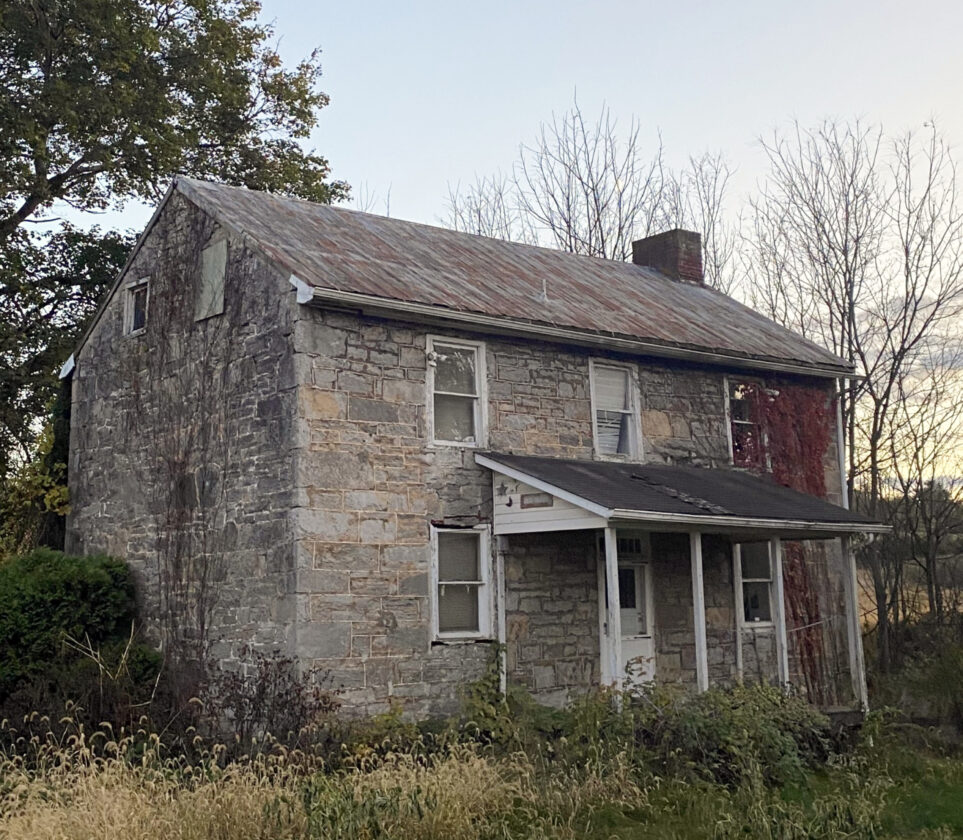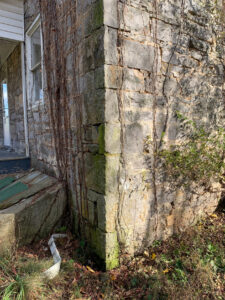Still standing…for now: Demolition of historic Beaver Farmhouse tabled
- PHOTO PROVIDED The Beaver Farmhouse is believed to be one of the oldest structures in the community, predating the Civil War and possibly even the Revolutionary War.
- PHOTOS PROVIDED Images show the deterioration of the building and give an idea of the amount of repairs that would need to be made to restore it.
- PHOTOS PROVIDED Images show the deterioration of the building and give an idea of the amount of repairs that would need to be made to restore it.

PHOTO PROVIDED The Beaver Farmhouse is believed to be one of the oldest structures in the community, predating the Civil War and possibly even the Revolutionary War.
BELLEFONTE — After the intervention of the Bellefonte Historical and Cultural Association, Bellefonte Borough Council voted 8-1 to table a motion allowing the Bellefonte Area School District to demolish a pre-Civil War farmhouse.
Located on school district property, the Beaver Farmhouse is believed to be one of the oldest structures in the community. The district has argued the building is a liability and unsuitable for adaptive reuse, while preservation advocates hope to see it preserved and repurposed as an educational resource.
At last week’s school board meeting, after hearing statements in defense of the building, the district pledged to do its due diligence in considering alternatives.
“Consistent with our mission, BHCA has been intervening in the school district’s attempt to demolish an old house on the margin of the campus of the new elementary school,” the Bellefonte Historical and Cultural Association (BHCA) said in a post over the weekend.
Though the exact age of the building at 1002 Airport Road, Bellefonte, is uncertain, it “might, and might not, be one of the earliest extant buildings in Bellefonte,” the association said.

PHOTOS PROVIDED Images show the deterioration of the building and give an idea of the amount of repairs that would need to be made to restore it.
According to BHCA member Phil Ruth, historical documents show the structure present as late as 1861, suggesting it was built during the antebellum period.
Mindy Crawford, executive director of Preservation PA, believes the house could be much older, potentially predating the reign of Queen Victoria.
“Mindy is a professional who knows plenty about old houses in Pennsylvania,” the association said. “She thought the house was likely constructed in the 18th century (1700s). This raises the question of which war the “bellum” in “antebellum” is referring to. Certainly the Civil War, but maybe the War of 1812 or even the Revolutionary War.”
If Crawford is correct, the Beaver Farmhouse is among the three or four oldest buildings in Bellefonte, and could be the oldest.
“In our community and across Pennsylvania, well-maintained historic architecture is increasingly rare. Everyday, buildings like this one, structures that have witnessed generations of our community’s history, are carelessly destroyed, taking with them irreplaceable stories, craftsmanship and architectural knowledge,” said Sadie Belsky, a Bellefonte alumna from Spring Mills and architecture student at Penn State.

PHOTOS PROVIDED Images show the deterioration of the building and give an idea of the amount of repairs that would need to be made to restore it.
Joined by other preservation advocates, she spoke before both the school board and borough council to outline concerns about the proposed demolition and urge that the building be repurposed.
“As a current architecture student with a passion for historic preservation, sustainability and community development, I believe this farmhouse represents not only an important piece of our local heritage but also a valuable educational and community resource,” she told council, asking for their voice in supporting preservation.
Belsky cited the irreplaceable value of historic architecture and the promise of adaptive reuse in her arguments.
That potential is already being explored by Bellefonte Area High School agriculture education teacher Myken Poorman, who has secured grants and made plans to transform the building into a “green” classroom and kitchen.
“Imagine students learning not just about nutrition in abstract terms, but actually growing food in school gardens, preparing it in a restored historic kitchen and understanding the complete cycle from soil to table. Imagine science classes studying sustainable building practices, insulation, water conservation and renewable energy, not from textbooks, but from a real building that demonstrates these principles. Imagine history classes exploring agricultural heritage, local foodways and the evolution of rural Pennsylvania architecture through direct engagement with authentic historic structure,” Belsky said.
In contrast, she said, tearing down the farmhouse would undercut those opportunities and send a troubling message.
“If we demolish the farmhouse, we send a different message: that when faced with a building that requires care and vision, the easier path of demolition is acceptable. We teach that history is disposable, that sustainable practices are secondary considerations and that ready-made educational opportunities can be rejected if they require effort to realize,” she said.
Other community members joined Belsky in advocating for the historic farmhouse, including Myken Poorman, Bob Daneker, local historian Matt Maris and BHCA President Joseph Griffin.
“(Beaver Farmhouse) has been standing in its little hollow for more than 150 years, occupied by four or five dozen souls. I imagine they worked the soil and made little impression on the contemporary politicians and captains of industry we still celebrate — the Bushes, the Beavers, the Curtins and the Brockerhoffs,” said Griffin before borough council (the same message was later relayed to the school board by BHCA secretary-treasurer Nancy Perkins).”This modest building is a memorial to those forgotten folk.”
Griffin said the farmhouse’s challenges could be addressed by securing the building, obtaining adequate insurance or finding a new use for the structure. He also suggested that a small parcel of land containing the building could be transferred to another owner. BHCA said that both they and the Bellefonte Historic Preservation Foundation would be interested in taking stewardship of the property.
“In fact, the cost of alternative solutions to the district’s problem might be less expensive than removing this house from our landscape,” said Griffin. “Demolition is the most regrettable outcome and should be avoided.”
In support of preservation, Congressman Glenn Thompson has pledged to back the building’s rehabilitation, recently increasing his contribution from $5,000 to $10,000. Shane Murphy, co-owner of Bellefonte Building Supply, has also offered to secure the structure at no cost to ensure it meets COG regulations.
While several community members spoke in favor of preserving the building, council also heard from school district officials advocating for the demolition permit to move forward.
“We are very sensitive to historic buildings and the nature of refurbishing buildings, however, as you know and has been stated, we’re not in the business of restoration,” said School Board President Jon Guizar.
He said demolition was originally delayed a decade ago to find ways to preserve the farmhouse; however, “we’ve not been able to do so,” and therefore the community is “prolonging the inevitable.”
For the district, ADA compliance is a major hurdle, and the building currently has no road access.
“This building would be extremely cost prohibitive to even consider that,” said Guizar. “Not to mention the fact that it would not retain its historical value if we try to put in elevators and regrade things for ADA ramps, etc.”
He said the program couldn’t move forward unless those changes were made.
“We can’t have an agriculture program only available to kids who can walk,” he said bluntly.
“From my lens, as the chief school administrator, it’s my job and responsibility to adhere to our mission,” said Superintendent Roy Rakszawski. “This building, this space as it is, does not provide a viable space for education.”
He went on to say that the building’s condition has deteriorated to the point that attempting to make it a functional educational space would be irresponsible to taxpayers.
“We prefer to use our tax dollars in an efficient manner and effective manner,” he said.
Echoing those concerns, Director of Physical Plant Tom Lannen said the building presents significant challenges for the district.
“The feasibility of this building remaining where it is, from my standpoint, is hard for the district — there are a lot of liabilities,” Lannen said.
District officials also cited concerns about liability, trespassing and water runoff issues as additional factors supporting the demolition.
He noted that while other educational uses of the land exist and the history of the building is compelling, “to have that as an educational space with ADA compliance, and having it up to what is needed as a district, I don’t think that’s something the district can handle.”
Ultimately, council voted to table the matter, with only council member Kent Bernier opposed.
Later in the week, at the school board meeting, Guizar said, “Administration is already setting up meetings with several entities to do their due diligence to look for other options.”
However, conversations with members of the BHCA indicate those discussions have not yet begun. Superintendent Roy Rakszawski was not available for comment by press time to confirm the district’s next steps.




